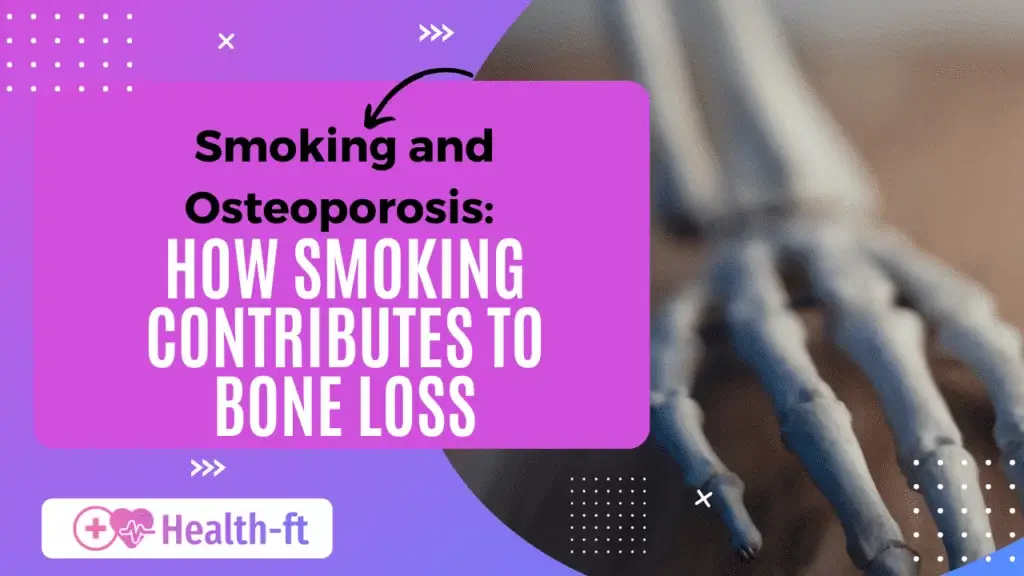Osteoporosis is a disease that renders the bones porous and consequently more liable to fracture. It is also known as the “silent disease” because bone loss occurs without pain until a fracture happens. It is widely recognized that many factors contribute to osteoporosis, but smoking is one of the main factors that aggravates bone quality and increases the likelihood of developing this disease. This article explores the link between smoking and osteoporosis, how smoking causes bone loss, and why smokers need to rethink their habits for the sake of their bones.
What is Osteoporosis?
Osteoporosis is a systemic skeletal disorder that affects the amount and quality of bone mass, mineral density, bone strength, and resistance to mechanical load, increasing the risk of fractures. Bone is a living tissue designed to endure the continuous bone resorption and formation process. Osteoporosis occurs when the loss of bone mass exceeds new bone formation, leading to fragile, hollow bones. Three sites are prone to osteoporotic fractures: the hip, spine, and wrist. These fractures often cause pain, disability, and, in many cases, death, particularly in the elderly. While age is a significant risk factor for osteoporosis, lifestyle choices—including smoking—also play a crucial role in its development.Does Smoking Cause Osteoporosis?
Yes, research confirms that smoking contributes to the development of osteoporosis. Multiple studies show that smokers have lower bone density than non-smokers and reduced bone strength, increasing the risk of fractures. Smoking affects bone health both directly and indirectly by accelerating skeletal tissue deterioration.
1. Reduced Bone Density
Studies indicate that nicotine and other chemicals in cigarettes weaken or inhibit the absorption and utilization of calcium, an essential nutrient for building bone mass. Calcium is crucial for bone mineralization, which keeps bones strong and prevents them from becoming porous. Poor calcium absorption reduces bone density, making bones more fragile and prone to breaking.
Research shows that bone density is generally lower in smokers than in non-smokers, with women being more affected than men. This loss of bone mass is especially noticeable in the spine and hip, which are common sites for osteoporosis-related fractures. Long-term smokers face a greater risk of osteoporosis and typically have lower bone mass than non-smokers.
2. Hormonal Changes
Smoking also disrupts hormonal balance in the body, particularly estrogen levels in women. Estrogen is essential for regulating osteoclast activity, which controls bone mineral density (BMD). Lower estrogen levels increase osteoclast activity, leading to excessive bone mass loss.
Smoking reduces estrogen levels, causing women who smoke to experience early menopause, which accelerates bone loss. This means female smokers are at a higher risk of osteoporosis compared to non-smokers.
In men, smoking decreases testosterone levels. Since testosterone plays a crucial role in maintaining bone density, lower levels can contribute to osteoporosis and an increased risk of fractures in older men.
3. Increased Production of Free Radicals
Smoking leads to the production of free radicals—unstable molecules that cause oxidative stress in the body. This oxidative stress damages bone cells and impairs the bone remodeling process. Free radicals inhibit the function of osteoblasts (bone-forming cells) while increasing osteoclast activity, resulting in a net loss of bone mass.
4. Poor Blood Circulation
Smoking negatively affects blood circulation, reducing oxygen supply and essential nutrients to the bones. Healthy blood circulation is crucial for bone health, as it delivers calcium and other minerals necessary for skeletal maintenance.
Poor circulation slows down bone healing and weakens the body’s ability to repair fractures. This is particularly concerning because individuals with osteoporosis already face an increased risk of fractures.
5. Inhibition of Vitamin D Absorption
Vitamin D is essential for calcium absorption and overall bone health. It helps regulate calcium levels in the blood and ensures proper bone mineralization. However, studies show that smokers tend to have lower vitamin D levels, further impairing calcium absorption. Smoking reduces circulating levels of active vitamin D, leading to poor calcium absorption and increased bone loss. A deficiency in vitamin D weakens bones, making them more prone to fractures.Does Smoking Contribute to Osteoporosis?
Yes, smoking has a direct link to the development and progression of osteoporosis. It impacts bone health through multiple mechanisms, including hormonal imbalances, oxidative stress, reduced calcium and vitamin D absorption, and impaired bone remodeling. Research indicates that smokers have a significantly higher risk of osteoporosis and fractures than non-smokers. The longer and heavier a person smokes, the greater their risk. For example, heavy smokers who consume more than a pack of cigarettes per day are much more likely to lose bone density than occasional or light smokers. The adverse effects of smoking on bone health accumulate over time. Even after quitting, former smokers may continue to experience some bone loss, but stopping smoking can slow the progression of osteoporosis and provide other health benefits.Is Smoking Bad for Your Bones?
Yes, smoking is highly detrimental to bone health. Tobacco affects all body systems, including the skeletal system. It contributes to osteoporosis, increases the risk of fractures, and impairs bone healing. Cigarettes contain toxic substances that interfere with bone remodeling, reduce bone mineral density, and weaken bone strength. Additionally, smoking-related diseases—such as heart disease and chronic obstructive pulmonary disease (COPD)—can indirectly affect bone health by further reducing circulation and nutrient absorption.Does Smoking Cause Bone Loss?
Absolutely. Smoking directly contributes to bone loss through several mechanisms, including:
- Impaired Calcium Absorption – Smoking reduces the body’s ability to absorb and utilize calcium, weakening bones.
- Reduced Estrogen and Testosterone Levels – Cigarette smoke lowers estrogen in women and testosterone in men, both essential for maintaining bone mass.
- Oxidative Stress – Free radicals from smoking damage bone cells, impairing bone formation and resorption.
- Poor Circulation – Smoking constricts blood vessels, slowing down bone healing and increasing fracture risk.
- Vitamin D Deficiency – Smoking lowers active vitamin D levels, further reducing calcium absorption and bone mineralization.
Over time, these effects contribute to a steady decline in bone density, increasing the risk of osteoporosis and fractures.
How to Protect Your Bones: Quitting Smoking
If you want to maintain strong bones and prevent osteoporosis, quitting smoking is crucial. While some damage may already be done, stopping smoking can slow the rate of bone loss and improve overall bone health. Additionally, incorporating a breathing exercise routine can support lung function and overall well-being, especially after quitting smoking.Here are some steps to protect your bones after quitting smoking:
- Calcium-Rich Diet – Consume calcium-rich foods like dairy products, leafy greens, and calcium-fortified cereals.
- Vitamin D Intake – Get enough from sunlight, diet, or supplements to aid calcium absorption.
- Weight-Bearing Exercise – Engage in activities like walking, running, weight training, and other exercises that strengthen bones.
- Bone Density Tests – Consult your doctor about getting a bone density test to assess your risk of osteoporosis.
- Limit Alcohol – Excessive alcohol consumption can weaken bones, so reducing intake can help protect bone health.
Conclusion
Smoking is a significant risk factor for osteoporosis and bone loss. Research has shown that smoking negatively impacts bone density, increases fracture risk, and slows down bone healing. It reduces calcium absorption, lowers beneficial hormones, increases oxidative stress, and interferes with vitamin D metabolism—ultimately leading to bone loss.
Quitting smoking is one of the most effective ways to protect bone health and reduce osteoporosis risk. Combined with a healthy diet, regular exercise, and medical check-ups, quitting smoking can help slow bone loss and improve overall well-being.
To safeguard your bones for the future, abandoning harmful habits like smoking and adopting a healthier lifestyle is essential.




